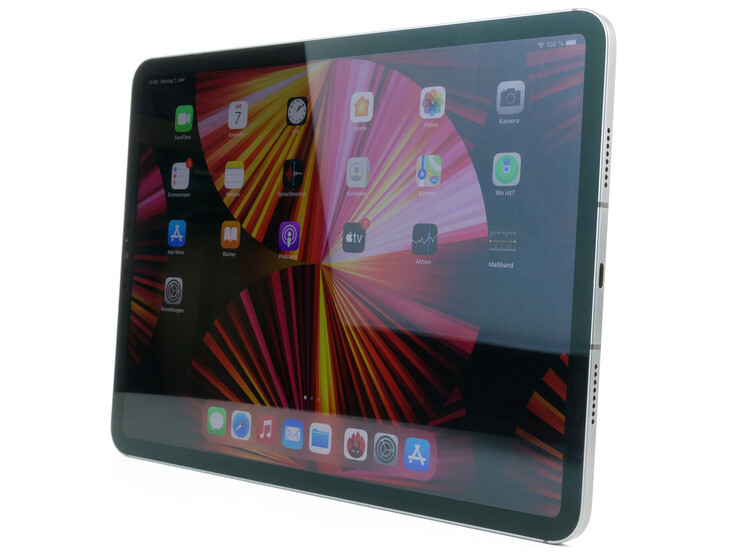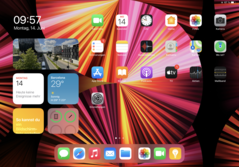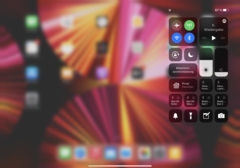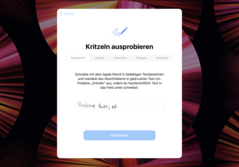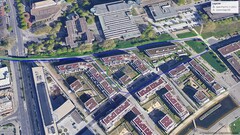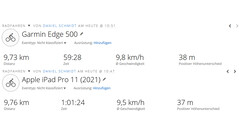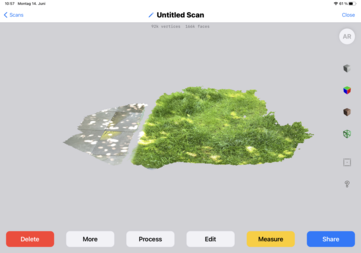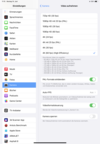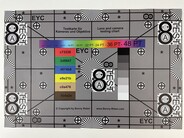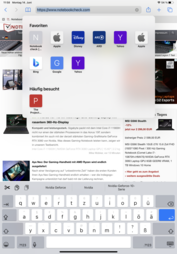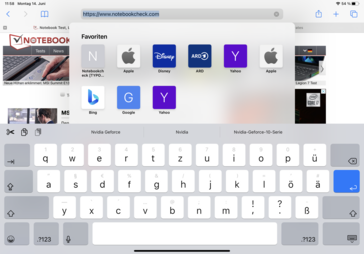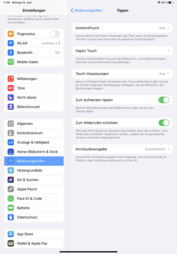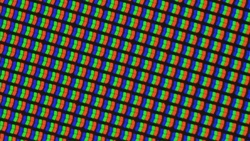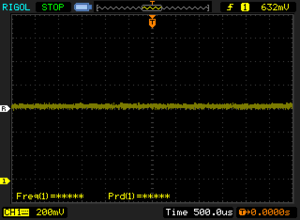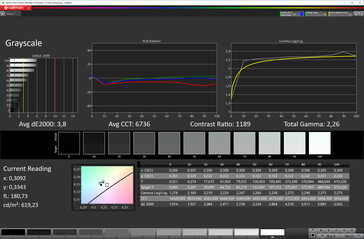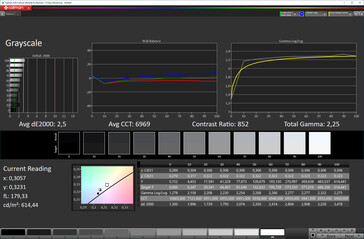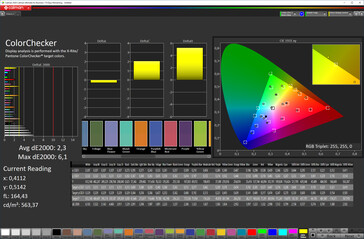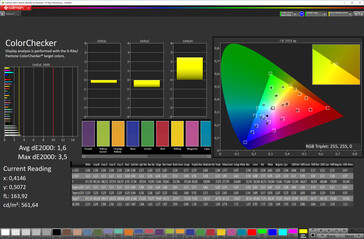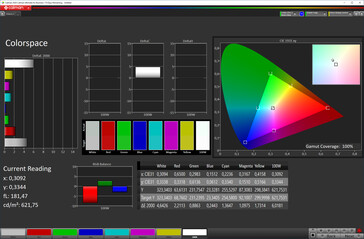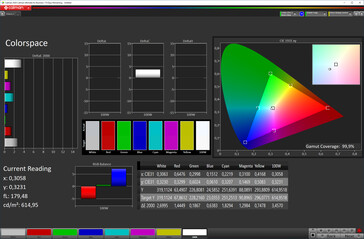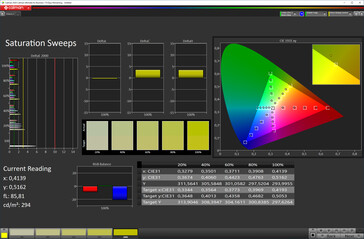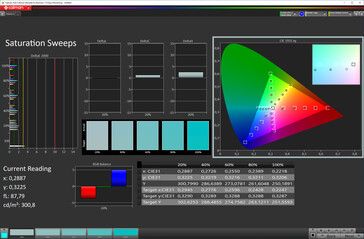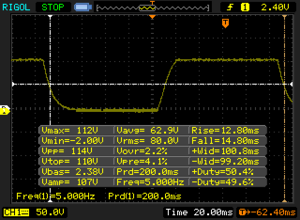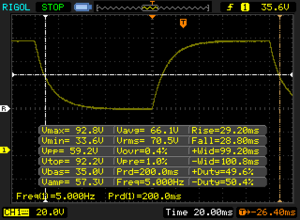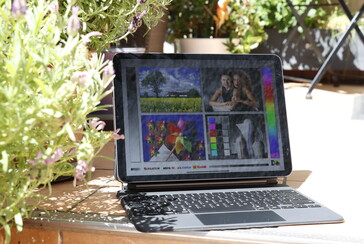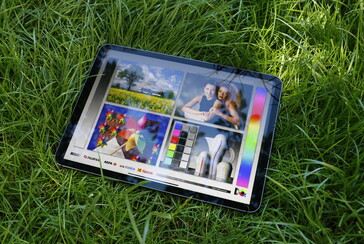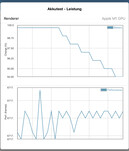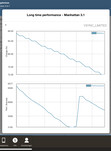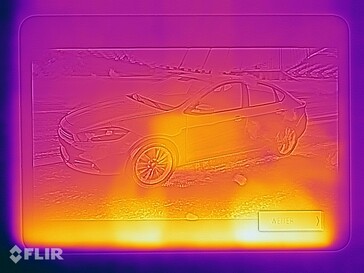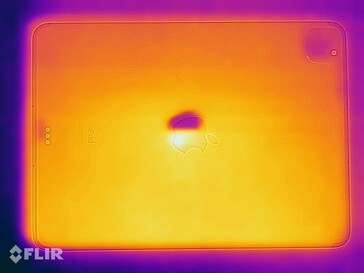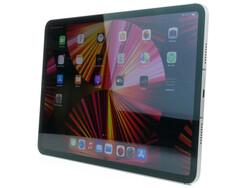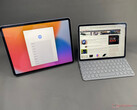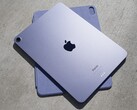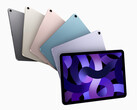Apple iPad Pro 11 (2021) tablet review - The Apple tablet sparks the M1-Turbo
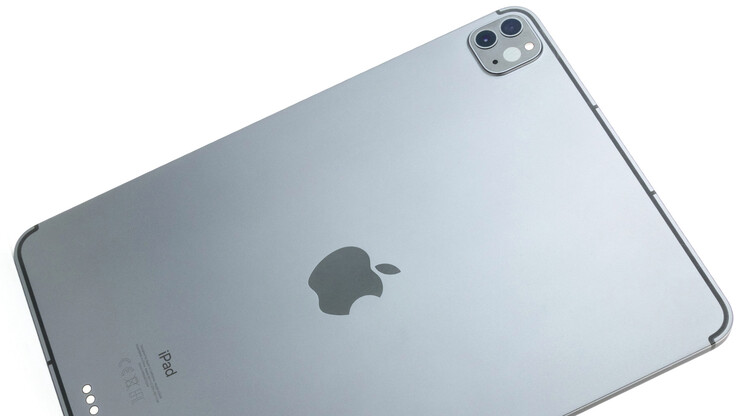
From the outside, the Apple iPad Pro 11 (2021) cannot be distinguished from its predecessor, although it is a few grams lighter. Inside, the Californians rely on the same chipset that they use in the MacBook Pro 13 and MacBook Air, thereby providing the iPad Pro 11 (2021) with a noticeable performance boost compared to the model that came before it. Also, the amount of RAM that Apple offers brings the tablet closer to laptops, but Apple continues to use iPadOS instead of splashing out on the fully-fledged Mac OS.
High-end tablets are now few and far between. Above all, the Galaxy Tab S7 is a solid Android alternative, while Lenovo also wants to gain a foothold in the upper echelons with the Tab P11 Pro.
Possible competitors in comparison
Rating | Date | Model | Weight | Height | Size | Resolution | Price |
|---|---|---|---|---|---|---|---|
| 92.6 % v7 (old) | 06 / 2021 | Apple iPad Pro 11 2021 M1, M1 8-Core GPU | 468 g | 5.9 mm | 11.00" | 2388x1668 | |
| 90.4 % v7 (old) | 04 / 2020 | Apple iPad Pro 11 2020 A12Z Bionic, A12Z Bionic GPU | 471 g | 5.9 mm | 11.00" | 2388x1668 | |
| 90.7 % v7 (old) | 11 / 2020 | Apple iPad Air 4 2020 A14, A14 Bionic GPU | 458 g | 6.1 mm | 10.90" | 2360x1640 | |
| 90.1 % v7 (old) | 10 / 2020 | Samsung Galaxy Tab S7 SD 865+ (Plus), Adreno 650 | 500 g | 6.3 mm | 11.00" | 2560x1600 | |
| 86.2 % v7 (old) | 04 / 2021 | Lenovo Tab P11 Pro SD 730G, Adreno 618 | 485 g | 5.8 mm | 11.50" | 2560x1600 | |
| 88.4 % v7 (old) | 08 / 2020 | Huawei MatePad Pro 10.8 Kirin 990, Mali-G76 MP16 | 460 g | 7.2 mm | 10.80" | 2560x1600 |
Case - Slim aluminium unibody
Apple remains true to the iPad Pro series with the new iPad Pro 11's slim design, but it is a few grams lighter again, as we mentioned earlier. This weight difference does not make a noticeable difference in everyday usage, though. As in previous years, Apple offers the tablet in Space Gray and Silver.
Our unit is well-built, and its slim chassis is comfortable to hold. The gaps between materials are tight and even too with no apparent flaws. Additionally, the tablet retains its predecessor's 83% screen-to-body ratio, which remains good. The iPad Pro 11 (2021) has slightly thicker bezels than its predecessor, but these make it easier to hold without accidentally triggering the display.
The iPad Pro 11 (2021) endured our attempts to twist it, and did not make a sound when we did so. Also, we had to press hard on the display to distort it, but the waves disappeared once we lifted our finger. In short, you should not fear any stability problems with the iPad Pro 11 (2021), despite its large surface area.
When choosing materials, Apple continues to focus on sustainability and uses for the iPad Pro, among other things, recycled aluminium, tin and rare earths.
Connectivity - Thunderbolt 3 / USB 4 in the iPad Pro 11 (2021)
The inconspicuous Type-C port in the Apple iPad Pro 11 (2021) is surprisingly powerful and supports the most modern transmission standards. In addition to Thunderbolt 3, the Type-C port also meets the new USB 4 standard, allowing the tablet to transfer data at up to 40 Gbit/s. However, Apple includes a USB 2.0 cable in the box, so you must purchase an additional cable if you want to utilise the tablet's fast data transfer. The Type-C port supports wired image output too and can output at up to 6K via DisplayPort. Those who use HDMI must settle on a lower resolution, though.
Storage expansion is still not possible, but Apple sells models with up to 2 TB of storage. The prices for the Wi-Fi variant are as follows:
- 8 GB RAM, 128 GB storage: US$799 (US$6.24 per GB)
- 8 GB RAM, 256 GB storage: US$899 (US$3.51 per GB)
- 8 GB RAM, 512 GB storage: US$1,099 (US$2.15 per GB)
- 16 GB RAM, 1 TB storage: US$1,499 (US$1.50 per GB)
- 16 GB RAM, 2 TB storage: US$1,899 (US$0.95 per GB
If you also need 5G support, you must pay an additional US$200 for each variant. So, the iPad Pro 11 (2021) can be configured up to US$2,099.
Software - iPad Pro M1 with iPadOS 14.6
The Apple iPad Pro 11 (2021) ships with iPadOS 14.6. The tablet supports the Scribble function in more languages now, including German. For reference, Scribble is Apple's optical character recognition (OCR) service that automatically recognizes handwritten words and converts them into text. The iPad Pro 11 (2021) can use Scribble system-wide, allowing you to replace a keyboard with the optional Apple Pencil.
In general, nothing has changed in the system design compared to the iPad Air 4. One advantage that all iPads offer compared to other tablets is a long-term supply of updates. For example, Apple has released iPadOS 15 to the iPad Air 2 (2014, Apple A8X) and the iPad 5 (2017, Apple A9), despite their age. We expect Apple to supply the new Pro model with at least five year's of updates, although Apple has not provided any official information on this.
Communication & GNSS - An Apple tablet with exact location
The iPad Pro 11 (2021) supports all current cellular standards, provided you purchase a variant with a cellular modem. The tablet offers a broad frequency spectrum and leaves nothing to be desired, in this regard. However, Apple dispenses with 5G mmWave for the European variants of the iPad Pro 11 (2021), which is the model we received. Our review maintained decent cellular network signal strength during our tests.
Wi-Fi 6 is available for home Wi-Fi, but the iPad Pro 11 (2021) does not support the newer Wi-Fi 6E standard. Unfortunately, Apple also refrains from using the 160 MHz frequency, which resulted in comparatively low transfer speeds when we tested our review unit with our reference Netgear Nighthawk AX12 router. As a result, if you opt for a 2 TB model and want to backup your data over Wi-Fi, then you must wait a little longer than you would on devices that support the 160 MHz band. The iPad Pro 11 (2021) maintained stable transfer speeds during our tests, though.
With a full five microphones, the iPad Pro 11 (2021) offers good communication quality, which is also convincing in everyday usage. Videotelephony moves even more into focus with the new iPad Pro 11 thanks to Centre Stage, which tracks people as they move around in shot. Specifically, the tablet's front-facing camera can follow you, framing you optimally even if you move or are off-centre for some reason. Centre Stage also works if there are multiple people in the shot. The technology works well in our experience, albeit only currently with FaceTime. However, Apple has opened Centre Stage to developers and, among other things, Zoom has already announced that it will support the function soon.
The iPad Pro 11 can use either a nano-SIM card or an eSIM.
Apple did not provide any precise information about the satellite navigation systems that the iPad Pro 11 (2021) supports. However, it can be assumed that it supports global systems like GPS, Glonass, BeiDou and Galileo. Also, the iPad Pro 11 (2021) probably supports the Japanese QZSS.
To determine our review unit's location accuracy, we took it on a short test ride with the Garmin Edge 500 bike computer. As the screenshots below show, the iPad Pro 11 (2021) consistently maps a more precise route than the Garmin Edge 500 does and with hardly any deviations. Hence, we could recommend using the iPad Pro 11 (2021) for navigation.
Cameras - Equipped for all situations
On the front, we find a 12 MP ultra-wide-angle lens with a 122° field of view. This is primarily intended for video telephony, and as a consequence, selfies look a bit muddy, especially with portrait mode active. In addition, the camera is not always able to compensate for bright areas in an image, resulting in burned-out areas. The iPad Pro 11 (2021) can record videos in up to 1080p at 60 FPS, for reference.
The camera setup on the back is unrivalled for a tablet; both lenses takes good pictures in daylight. Moreover, the short recording distance of about 5 centimetres is ideal for taking photos of documents. Apple has also included an auxiliary LED for when there is little light. In addition, the iPad Pro 11 (2021) has an ultra-wide-angle camera that takes decent photos. In our opinion, the iPad Pro 11 (2021) has a better ultra-wide-angle camera than those in many smartphones. At best, the tablet can record videos in 4K at 60 FPS. The results are convincing, but there is no Dolby Vision support, unlike on modern iPhones.
The LiDAR scanner is already an old acquaintance that Apple included in the previous model. The sensor can measure and capture three-dimensional representations of objects, rooms and even people.
Image comparison
Choose a scene and navigate within the first image. One click changes the position on touchscreens. One click on the zoomed-in image opens the original in a new window. The first image shows the scaled photograph of the test device.
WeitwinkelWeitwinkelUltraweitwinkel5-facher ZoomLow-Light
Under controlled lighting conditions, the new iPad Pro 11's cameras confirm our thoughts that we discussed above. Our review unit captures details sharply and richly while not compromising on its contrast ratio. As our test shots show, the iPad Pro 11 (2021) maintains contrast levels into the edges of an image.
However, the tablet reproduces colours too brightly and with an emphasis on oversaturation. The latter is particularly true when it comes to dark green, but our review unit does a good job overall.
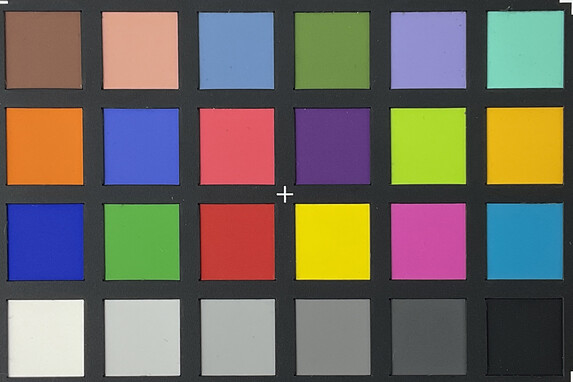

Accessories & Warranty - The iPad Pro 11 still comes with a charger
Apple includes a few accessories with the iPad Pro 11 (2021), namely a 20 W charger, a USB Type-C data or charging cable and a SIM tool. Some safety instructions and a brief description in multiple languages about the tablet can also be found in the box, as can two Apple stickers.
The iPad Pro 11 (2021) comes with 12 months manufacturer's warranty, which is separate from any warranty that a third-party retailer offers. You can read more about warranties in our dedicated FAQ. Apple still offers its AppleCare+ program, which covers two incidents of accidental damage over two years. AppleCare+ costs US$129 for the iPad Pro 11, which you can also repay in part at US$5.99 per month. Apple charges a US$49 service fee for each incident, or US$29 for one with an Apple Pencil or an Apple-branded iPad keyboard. These prices exclude taxes, for reference.
In addition to adapters, data cables, power supplies and covers, Apple also sells keyboard covers for the iPad Pro 11 (2021). Ones designed for older iPad Pro 11 models work with the 2021 edition. The Magic Keyboard is now also available in white, while the tablet is compatible with the Apple Pencil 2.
Input Devices & Operation - Face ID provides security
The new iPad Pro 11's capacitive touchscreen is protected by an unspecified glass, which provides no resistance when we swipe or slide our finger across. However, the screen quickly looks rather greasy, even with the grease-repellent coating that Apple applies. Nevertheless, the touchscreen responds precisely and rapidly, not least because of the 120 Hz panel behind it. Correspondingly, navigating through iPadOS feels fast and fluid.
Face ID, which recognizes faces reliably and quickly, provides biometric security on the iPad Pro 11 (2021). The three-dimensional face recognition is also more secure than 2D variants that only utilise the front-facing camera.
Like its predecessor, this iPad Pro 11 (2021) is compatible with the Apple Pencil 2. In addition, you can also use the tablet with keyboards produced by Apple and third-party manufacturers.
Display - An 11-inch iPad without mini-LED
The IPS display of the iPad Pro 11 (2021) is practically unchanged compared to the previous year's model. The display measures 11-inches and resolves at 2,388 x 1,668 pixels. Our review unit averaged 598 cd/m² across its panel during our tests and evenly distributed light and dark areas in APL50. Setting the display to manual mode allows the tablet to make use of the full light spectrum, too.
The illumination is even, but there is room for improvement. Additionally, our review unit has a higher black value than its predecessor, although this does not prevent it from achieving a strong contrast ratio. The display does not suffer from any backlight bleed or haloing, either.
The display can also operate at up to 120 Hz, allowing it to display content smoothly. Positively, Apple does not use pulse-width modulation (PWM) to regulate the display's brightness levels. Hence, you should not suffer from eye strain or headaches when using the iPad Pro 11 (2021) if you are PWM sensitive.
| |||||||||||||||||||||||||
Brightness Distribution: 88 %
Center on Battery: 627 cd/m²
Contrast: 1425:1 (Black: 0.44 cd/m²)
ΔE ColorChecker Calman: 1.6 | ∀{0.5-29.43 Ø4.77}
ΔE Greyscale Calman: 2.5 | ∀{0.09-98 Ø5}
99.9% sRGB (Calman 2D)
Gamma: 2.25
CCT: 6969 K
| Apple iPad Pro 11 2021 IPS, 2388x1668, 11" | Apple iPad Pro 11 2020 IPS, 2388x1668, 11" | Apple iPad Air 4 2020 IPS, 2360x1640, 10.9" | Samsung Galaxy Tab S7 LTPS, 2560x1600, 11" | Lenovo Tab P11 Pro OLED, 2560x1600, 11.5" | Huawei MatePad Pro 10.8 IPS, 2560x1600, 10.8" | Apple MacBook Air 2020 M1 Entry IPS, 2560x1600, 13.3" | |
|---|---|---|---|---|---|---|---|
| Screen | 20% | 3% | -9% | -19% | -21% | 1% | |
| Brightness middle (cd/m²) | 627 | 617 -2% | 509 -19% | 554 -12% | 372 -41% | 606 -3% | 417 -33% |
| Brightness (cd/m²) | 598 | 585 -2% | 486 -19% | 535 -11% | 375 -37% | 579 -3% | 395 -34% |
| Brightness Distribution (%) | 88 | 84 -5% | 93 6% | 91 3% | 95 8% | 89 1% | 91 3% |
| Black Level * (cd/m²) | 0.44 | 0.36 18% | 0.39 11% | 0.33 25% | 0.32 27% | 0.39 11% | |
| Contrast (:1) | 1425 | 1714 20% | 1305 -8% | 1679 18% | 1894 33% | 1069 -25% | |
| Colorchecker dE 2000 * | 1.6 | 0.94 41% | 1.3 19% | 2.1 -31% | 1.8 -13% | 2.9 -81% | 1.12 30% |
| Colorchecker dE 2000 max. * | 3.5 | 1.87 47% | 2.8 20% | 7.1 -103% | 4.2 -20% | 6 -71% | 2.71 23% |
| Greyscale dE 2000 * | 2.5 | 1.4 44% | 2.2 12% | 1.6 36% | 2.8 -12% | 4.3 -72% | 1.7 32% |
| Gamma | 2.25 98% | 2.156 102% | 2.21 100% | 2.32 95% | 2.29 96% | 2.22 99% | 2207 0% |
| CCT | 6969 93% | 6733 97% | 6833 95% | 6623 98% | 6718 97% | 7272 89% | 6870 95% |
| Color Space (Percent of AdobeRGB 1998) (%) | 99.3 | ||||||
| Colorchecker dE 2000 calibrated * | 0.77 |
* ... smaller is better
Screen Flickering / PWM (Pulse-Width Modulation)
| Screen flickering / PWM not detected | |||
In comparison: 53 % of all tested devices do not use PWM to dim the display. If PWM was detected, an average of 8081 (minimum: 5 - maximum: 343500) Hz was measured. | |||
We checked the display quality of Apple's latest 11-inch tablet with CalMAN and a photo spectrometer. The results are at a good level, albeit worse than its predecessor's. If you deactivate True Tone mode, then the display will reproduce colours in a more lifelike manner. Unfortunately, deactivating True Tone does not help the display's ability to reproduce greyscale, which remains too cool.
Display Response Times
| ↔ Response Time Black to White | ||
|---|---|---|
| 27.6 ms ... rise ↗ and fall ↘ combined | ↗ 12.8 ms rise | |
| ↘ 14.8 ms fall | ||
| The screen shows relatively slow response rates in our tests and may be too slow for gamers. In comparison, all tested devices range from 0.1 (minimum) to 240 (maximum) ms. » 69 % of all devices are better. This means that the measured response time is worse than the average of all tested devices (20.2 ms). | ||
| ↔ Response Time 50% Grey to 80% Grey | ||
| 58 ms ... rise ↗ and fall ↘ combined | ↗ 29.2 ms rise | |
| ↘ 28.8 ms fall | ||
| The screen shows slow response rates in our tests and will be unsatisfactory for gamers. In comparison, all tested devices range from 0.165 (minimum) to 636 (maximum) ms. » 94 % of all devices are better. This means that the measured response time is worse than the average of all tested devices (31.6 ms). | ||
The iPad Pro 11 (2021) impressed us when we used it outdoors. The display gets exceptionally bright, allowing it to be read even in direct sunlight.
However, we would recommend against doing this for a long time because the aluminium case heats up rapidly in the sun. Not only did our review unit quickly feel uncomfortable in our hands, it also dimmed its display. However, we encountered no problems when using the iPad Pro 11 (2021) in the shade on a hot day.
The iPad Pro 11 (2021) has stable viewing angles, and it does not show any colour inversions even at obtuse angles. There is a visible decrease in brightness at obtuse angles though, although this is of no consequence in everyday use. We did not notice any IPS glow or ghosting effects in our test device, either.
Performance - The Apple M1 takes it into a new dimension
The Apple iPad Pro 11 (2021) has, with the Apple M1, the same SoC that Apple uses in the MacBook Air. Our review unit can also fall back on 8 GB of RAM, like the MacBook Air. If you opt for a 1 TB or 2 TB variant of Apple's latest 11-inch tablet, then you also get 16 GB of RAM. Overall, the iPad Pro 11 (2021) should offer approximately 50% more CPU and 40% more GPU performance than its predecessor.
Benchmark results confirm this, too. For example, our review unit outscores last year's model by 54% in Geekbench 5.3 multi-core and 47% in 3DMark Sling Shot Unlimited (Physics). However, the iPad Pro 11 (2021) cannot transfer this lead to 3DMark Extreme, where it enjoys only a 3% lead over its predecessor.
The increase in GPU performance is also enormous. Depending on the scenario, the performance increase between the iPad Pro 11 (2021) and last year's model in GFXBench offscreen tests is anywhere from 58 to 113%. The iPad Pro 11 (2021) can even outscore the MacBook Air in onscreen tests, principally because the iPad has a higher refresh rate than its MacBook sibling. Conversely, the offscreen results show that the MacBook Air has more performance left in the tank than the iPad Pro 11 (2021), implying that the former has superior cooling performance than the latter.
Our review unit works smoothly and is free from any stutters or jerkiness. We encountered no hiccups when multitasking with the iPad Pro 11 (2021), either. In our opinion, the increased performance that the iPad Pro 11 (2021) offers will be of particular interest to those who edit videos or do any graphically demanding work.
| AnTuTu v8 - Total Score | |
| Average Apple M1 (1017194 - 1037959, n=2) | |
| Apple iPad Pro 11 2021 | |
| Apple iPad Pro 11 2020 | |
| Apple iPad Air 4 2020 | |
| Samsung Galaxy Tab S7 | |
| Huawei MatePad Pro 10.8 | |
| Lenovo Tab P11 Pro | |
| Jetstream 2 - 2.0 Total Score | |
| Average Apple M1 (175.4 - 191.3, n=8) | |
| Apple iPad Pro 11 2021 (Safari 14.1) | |
| Apple iPad Air 4 2020 (Safari Mobile 14) | |
| Average of class Tablet (22.3 - 395, n=68, last 2 years) | |
| Apple iPad Pro 11 2020 (Safari 14.1) | |
| Apple iPad Pro 11 2020 (Chrome 80) | |
| Samsung Galaxy Tab S7 (Chrome86) | |
| Huawei MatePad Pro 10.8 (Huawei Browser V10.1.2) | |
| Lenovo Tab P11 Pro (Chrome 89.0.4389.105) | |
| JetStream 1.1 - Total Score | |
| Average Apple M1 (402 - 436, n=7) | |
| Apple iPad Pro 11 2021 (Safari 14.1) | |
| Apple iPad Air 4 2020 (Safari Mobile 14) | |
| Apple iPad Pro 11 2020 (Chrome 80) | |
| Samsung Galaxy Tab S7 (Chrome86) | |
| Huawei MatePad Pro 10.8 (Huawei Browser V10.1.2) | |
| Lenovo Tab P11 Pro (Chrome 89.0.4389.105) | |
| WebXPRT 3 - Overall | |
| Average Apple M1 (216 - 304, n=8) | |
| Average of class Tablet (39 - 480, n=24, last 2 years) | |
| Apple iPad Pro 11 2021 | |
| Apple iPad Air 4 2020 (Safari Mobile 14) | |
| Apple iPad Pro 11 2020 (Safari 14.1) | |
| Apple iPad Pro 11 2020 (Chrome 80) | |
| Samsung Galaxy Tab S7 (Chrome86) | |
| Huawei MatePad Pro 10.8 (Huawei Browser V10.1.2) | |
| Lenovo Tab P11 Pro (Chrome 89.0.4389.105) | |
| Speedometer 2.0 - Result 2.0 | |
| Average Apple M1 (209 - 265, n=8) | |
| Apple iPad Pro 11 2021 (Safari 14.1) | |
| Average of class Tablet (2.59 - 790, n=54, last 2 years) | |
| Apple iPad Air 4 2020 (Safari Mobile 14) | |
| Apple iPad Pro 11 2020 (Safari 14.1) | |
| Samsung Galaxy Tab S7 (Chrome86) | |
| Huawei MatePad Pro 10.8 (Huawei Browser V10.1.2) | |
| Lenovo Tab P11 Pro (Chrome 89.0.4389.105) | |
| Octane V2 - Total Score | |
| Average Apple M1 (62055 - 66974, n=8) | |
| Apple iPad Pro 11 2021 (Safari 14.1) | |
| Apple iPad Air 4 2020 (Safari Mobile 14) | |
| Average of class Tablet (763 - 138481, n=94, last 2 years) | |
| Apple iPad Pro 11 2020 (Safari 14.1) | |
| Apple iPad Pro 11 2020 (Chrome 80) | |
| Samsung Galaxy Tab S7 (Chrome86) | |
| Huawei MatePad Pro 10.8 (Huawei Browser V10.1.2) | |
| Lenovo Tab P11 Pro (Chrome 89.0.4389.105) | |
| Mozilla Kraken 1.1 - Total | |
| Lenovo Tab P11 Pro (Chrome 89.0.4389.105) | |
| Average of class Tablet (243 - 27101, n=79, last 2 years) | |
| Huawei MatePad Pro 10.8 (Huawei Browser V10.1.2) | |
| Samsung Galaxy Tab S7 (Chrome86) | |
| Apple iPad Pro 11 2020 (Chrome 80) | |
| Apple iPad Pro 11 2021 (Safari 14.1) | |
| Average Apple M1 (418 - 516, n=8) | |
| Apple iPad Air 4 2020 (Safari Mobile 14) | |
* ... smaller is better
Games - A lot of potential
The Apple iPad Pro 11 (2021) is actually too powerful for all the games found on the Apple App Store. Simply, its GPU has more horsepower than any mobile game currently requires. Also, existing games cannot run at higher frame rates than they could already on an iPhone or iPad Air. Almost certainly, Apple has done this to maximize the new iPad Pro 11's battery life. Nevertheless, it would have been desirable to offer a few exclusive titles for the iPad Pro to demonstrate its possibilities. In addition, our review unit's display has relatively long response times.
The above does not change that the iPad Pro 11 (2021) is a powerful gaming companion, in our opinion. Not only does it have a 120 Hz display, it also has convincing speakers. Moreover, all the games that we tested ran smoothly, as our GameBench results below demonstrate. The iPad Pro 11 (2021) supports PlayStation and Xbox controllers for reference. However, the iPad Pro 11 (2021) becomes quite heavy in the long run when gaming on the go.
Emissions - Four speakers with Dolby Atmos
Temperature
The surface temperatures of the Apple iPad Pro 11 (2021) are inconspicuous at all times, and the tablet does not even get lukewarm when subjected to constant load.
We checked how the iPad deals with waste heat, among other things, with the GFXBench battery test. We ran each benchmark thirty times on a loop, logging framerates and the tablet's battery life throughout. Our review unit handled the older T-Rex benchmark with ease and continuously maintained maximum performance. By contrast, the more demanding Manhattan benchmark caused the iPad Pro 11 (2021) to drop its performance continuously, although it ramped up again briefly during the 21st run. Our review unit returned to previous levels after this point though, which corresponded to a performance of loss of up to 23% compared to its peak.
The iPad Pro 11 (2021) behaves similarly in the 3DMark stress test. However, it always remains 26% faster than the best score that the iPad Air 2020 (Apple A14) could manage.
| 3DMark | |
| Wild Life Stress Test Stability | |
| Lenovo Tab P11 Pro | |
| Apple iPad Air 4 2020 | |
| Apple iPad Pro 11 2021 | |
| Wild Life Extreme Stress Test | |
| Apple iPad Air 4 2020 | |
| Apple iPad Pro 11 2021 | |
(+) The maximum temperature on the upper side is 34 °C / 93 F, compared to the average of 33.6 °C / 92 F, ranging from 20.7 to 53.2 °C for the class Tablet.
(+) The bottom heats up to a maximum of 29.2 °C / 85 F, compared to the average of 33.2 °C / 92 F
(+) In idle usage, the average temperature for the upper side is 29.8 °C / 86 F, compared to the device average of 30 °C / 86 F.
Speakers
Apple continues to equip the iPad Pro 11 with four speakers that support Dolby Atmos. The ones in our review unit sound good and deliver a balanced sound right into the deep mids. The quad speakers only really dispense with bass tones, in our opinion.
You can connect wireless headphones and speakers via Bluetooth 5.0 (SBC/AAC) or USB Type-C over a wired connection. Apple has not included a 3.5 mm headphone jack, but it sells appropriate USB Type-C adapters.
Apple iPad Pro 11 2021 audio analysis
(+) | speakers can play relatively loud (83.5 dB)
Bass 100 - 315 Hz
(±) | reduced bass - on average 11.1% lower than median
(±) | linearity of bass is average (13.2% delta to prev. frequency)
Mids 400 - 2000 Hz
(+) | balanced mids - only 4% away from median
(+) | mids are linear (4.6% delta to prev. frequency)
Highs 2 - 16 kHz
(+) | balanced highs - only 2.2% away from median
(+) | highs are linear (5.2% delta to prev. frequency)
Overall 100 - 16.000 Hz
(+) | overall sound is linear (11.4% difference to median)
Compared to same class
» 13% of all tested devices in this class were better, 4% similar, 84% worse
» The best had a delta of 7%, average was 20%, worst was 129%
Compared to all devices tested
» 7% of all tested devices were better, 2% similar, 91% worse
» The best had a delta of 4%, average was 24%, worst was 134%
Samsung Galaxy Tab S7 audio analysis
(+) | speakers can play relatively loud (88.4 dB)
Bass 100 - 315 Hz
(-) | nearly no bass - on average 15% lower than median
(±) | linearity of bass is average (9.6% delta to prev. frequency)
Mids 400 - 2000 Hz
(+) | balanced mids - only 1.6% away from median
(+) | mids are linear (2.9% delta to prev. frequency)
Highs 2 - 16 kHz
(+) | balanced highs - only 1.7% away from median
(+) | highs are linear (4.3% delta to prev. frequency)
Overall 100 - 16.000 Hz
(+) | overall sound is linear (10.4% difference to median)
Compared to same class
» 8% of all tested devices in this class were better, 3% similar, 89% worse
» The best had a delta of 7%, average was 20%, worst was 129%
Compared to all devices tested
» 5% of all tested devices were better, 1% similar, 94% worse
» The best had a delta of 4%, average was 24%, worst was 134%
Power Management - A weak power supply in the box
Power Consumption
The new iPad Pro 11 consumes more power than its predecessor when idling with its display set to maximum brightness, but significantly less under load. The latter will be because of the newer model's stronger SoC, which it cannot fully utilise in our scenarios and tests. In saying that, adjusting the display's brightness shows that the iPad Pro 11 (2021) can consume plenty of power and enough to exhaust the included 20 W charger.
Our review unit takes about three hours to recharge fully with the stock charger. A more powerful charger would reduce this time, though.
| Off / Standby | |
| Idle | |
| Load |
|
Key:
min: | |
| Apple iPad Pro 11 2021 7538 mAh | Apple iPad Pro 11 2020 7538 mAh | Apple iPad Air 4 2020 mAh | Samsung Galaxy Tab S7 8000 mAh | Lenovo Tab P11 Pro 8600 mAh | Huawei MatePad Pro 10.8 7250 mAh | |
|---|---|---|---|---|---|---|
| Power Consumption | -22% | -19% | 5% | 14% | -5% | |
| Idle Minimum * (Watt) | 1.01 | 1.3 -29% | 1.3 -29% | 1.16 -15% | 1.55 -53% | 1.98 -96% |
| Idle Average * (Watt) | 6.2 | 3.5 44% | 7.89 -27% | 4.42 29% | 4.91 21% | 5.66 9% |
| Idle Maximum * (Watt) | 6.23 | 5.6 10% | 7.91 -27% | 4.43 29% | 5.02 19% | 5.69 9% |
| Load Average * (Watt) | 8.99 | 12.5 -39% | 9.28 -3% | 8.86 1% | 4.38 51% | 6.96 23% |
| Load Maximum * (Watt) | 9.89 | 19.2 -94% | 10.78 -9% | 11.6 -17% | 6.81 31% | 6.98 29% |
* ... smaller is better
Power consumption: Geekbench, GFXBench and idle (150 cd/m²)
Battery Life
The iPad Pro 11 (2021) has improved in terms of minimum and maximum battery life compared to its predecessor. Conversely, the newer model falls short of last year's model in our Wi-Fi battery life test where we set the brightness to 150 cd/m². Overall, the iPad Pro 11 (2021) achieves excellent runtimes and has stellar battery life. Only the iPad Pro 11 (2020) and the Huawei MatePad Pro perform better here.
| Apple iPad Pro 11 2021 7538 mAh | Apple iPad Pro 11 2020 7538 mAh | Apple iPad Air 4 2020 mAh | Samsung Galaxy Tab S7 8000 mAh | Lenovo Tab P11 Pro 8600 mAh | Huawei MatePad Pro 10.8 7250 mAh | Apple MacBook Air Late 2020 (M1, 8 Core GPU, 8 GB RAM) 4380 mAh | |
|---|---|---|---|---|---|---|---|
| Battery runtime | -8% | -5% | -11% | -10% | -8% | 14% | |
| Reader / Idle (h) | 38 | 33.4 -12% | 34 -11% | 32.7 -14% | 27.4 -28% | 31.3 -18% | |
| H.264 (h) | 15.5 | 15.6 1% | 11.2 -28% | 14.8 -5% | 14.2 -8% | 15.2 -2% | |
| WiFi v1.3 (h) | 13.7 | 15 9% | 11.7 -15% | 13.5 -1% | 10.4 -24% | 14.9 9% | 15.6 14% |
| Load (h) | 4.8 | 3.3 -31% | 6.5 35% | 3.7 -23% | 5.8 21% | 3.9 -19% |
Pros
Cons
Verdict - A strong upgrade in the shadow of the iPad Pro 12.9
The Apple iPad Pro 11 is, again, a successful tablet. The 2021 model is difficult or even impossible to beat on performance and features, especially considering its computing power and the state-of-the-art connections it offers. In short, nobody can match Apple's Pro tablet series, currently. Thunderbolt 3 and USB 4 connectivity enable high data transfer speeds and connecting numerous peripherals and high-resolution displays.
What Apple should still be docked marks for is the lack of storage expandability, even if drives are formatted correctly. We would have wished Apple to use the most modern Wi-Fi standard in this price range, rather than a stripped-down version of Wi-Fi 6. It could have more precisely calibrated the tablet's display too, even if Samsung does not do any better in this regard with the Galaxy Tab S7. The situation is different with the response times, where Apple's biggest competitor, Samsung, performs better.
If you are searching for a pro-grade tablet, you can hardly ignore the Apple iPad Pro 11 (2021).
We recommend the iPad Pro 11 (2021) to everyone who needs fast hardware to, for example, edit videos or large image files. Additionally, the iPad Pro 11 (2021) is an excellent choice for those who want a tablet with extended software support. Android tablets are cheaper and more flexible, especially the Galaxy Tab S7. The Lenovo Tab P11 Pro is also an exciting alternative, which is already available with a keyboard and pen in a bundle. Lenovo's option costs less than half of the new iPad Pro 11 (2021) with this bundle, too. If you want to stay in the Apple cosmos, you will also find a strong alternative with the latest iPad Air. The same applies to the MacBook Air, which offers slightly better battery life, but with the trade-offs of a darker display and a heavier chassis.
Price & Availability
Apple iPad Pro 11 2021
- 06/14/2021 v7 (old)
Daniel Schmidt


